Morocco Canary Islands Cape Verde Islands Atlantic Crossing Barbados

The first challenge was actually getting into Morocco. The coast is very inhospitable with almost no anchorages. There is a marina near Rabat, but the bar across the river into the marina is quite shallow and with any kind of sea running it becomes impassable. Friends that had made the overnight sail from Gibraltar a few days before us arrived to find it way too rough and they were forced to go 50 miles further down the coast to a tenuous harbor that did not really have room for them. However we were lucky I had timed our arrival for high tide and the seas were relatively calm.
The previous sentence does not really do justice to the complexities that sometimes confront sailors. The tides and resulting currents in and out of the entrance to the Med at Gibraltar are significant. If you time the current wrong and it is against you, your speed could be only 1-2 miles per hour, meaning your exit into the Atlantic takes 8 hours instead of 2-3 hours. You then have a 150 mile trip to the river entrance in Morocco and you want to arrive there at high tide because of the shallow entrance. Depending on the wind you could be sailing these 150 miles in 24 hours or 36 hours. But wait there's more...You need daylight to come in over the bar so you have to time your arrival with both high tide and daylight and you also would prefer daylight to leave Gibraltar as there are dozens and dozens of huge ships going in and out of the channel which you have to cross. A sailboat crossing a busy ship channel is like a squirrel crossing an interstate- and doing it in the dark is that much scarier. We were able to time our exit from Gibraltar early in the am and also time our arrival well and crossing the bar only involved a few moments of nervousness. The day after we arrived the bar was closed for an entire week as the swells were to big to allow entry or exit.
I had first traveled to Morocco in 1971 and to a wide eyed high school student on his first trip overseas it was the most exotic place imaginable. Snake charmers, veiled women, goat heads for sale in the market, exotic sights and smells and millions of people crammed into the giant rabbit warren that is the walled medina in Fez. There were few foreigners then and I was convinced that as a westerner I could vanish in the twisting alleyways of the medina and my family would not not even have a place to start looking- it would simply be as if I had never existed. To try and blend in I bought a "djellaba", the typical hooded Moslem men's robe, and then I cut a hole in the front so I could surreptitiously take pictures of all the incredible sights.
Returning to Morocco now in the days when there are Lonely Planet guides to everywhere I was ready for disappointment. I need not have worried, while there was now electricity and neon signs and thousands of tourists the medina still maintained its chaotic, wild heart. With our guest Karen and cruising friends Jimmy and Carolyn from Blue Moon we set off to explore Fez, Rabat and enchanting Marrakech.
Click on any photo to enlarge it. Then hit your back button to return here.
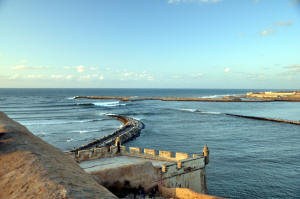
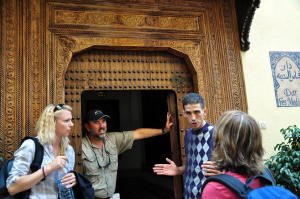
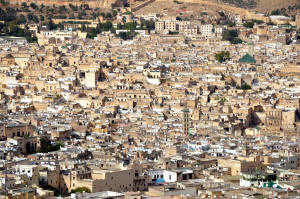
The shallow entrance bar
Carolyn, Jimmie, guide and Karen
Overview of Fez medina
One of the more incredible artistic talents of the
Moroccans is making tile mosaics. First the ceramic tiles are
made and fired each in one solid color. Next the mosaic maker will select
say a piece of blue tile and one worker will cut it to the shape it needs to be,
then a second worker will bevel the edges so it will fit into the plaster
backing. Look at the white star below and realize it took 16 perfect cuts
to get the shape, then another 16 perfect cuts to bevel the edges and all is
done just by hand with a hammer.
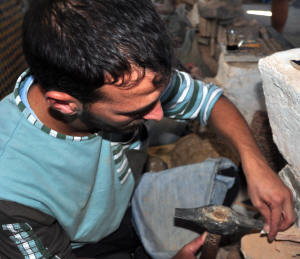
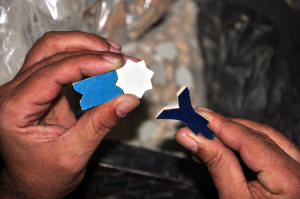
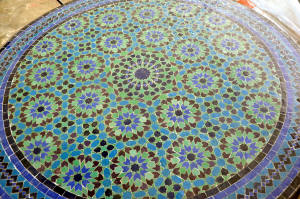
Cutting tiles
Putting the pieces together
Table
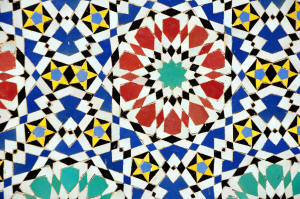
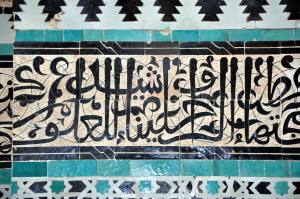
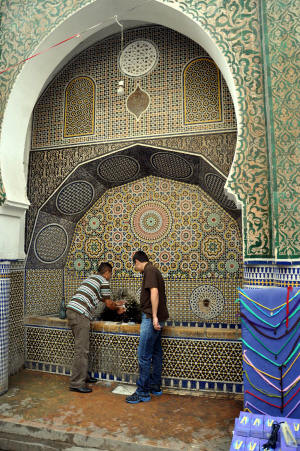
Tile details
Even tile script writing
Tile fountains everywhere
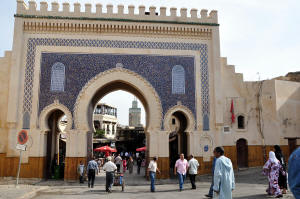
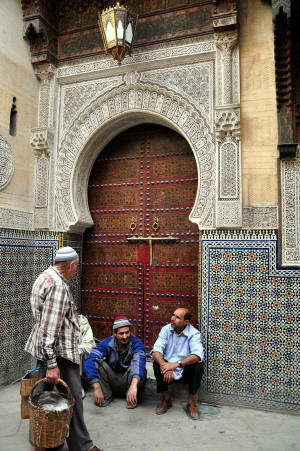
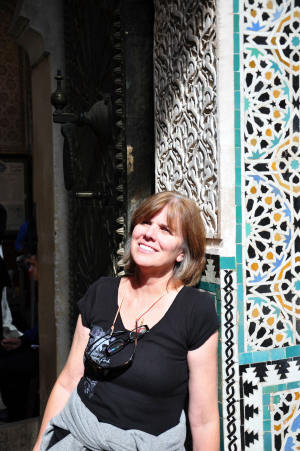
Entrance to the medina- near the hostel I stayed in when I first visited Morocco
in 1971. Karen in front of the
doorway to a madrassa. I had taken a similar picture of a friend in this
same doorway 41 years previously.
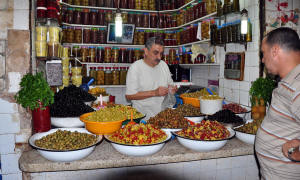
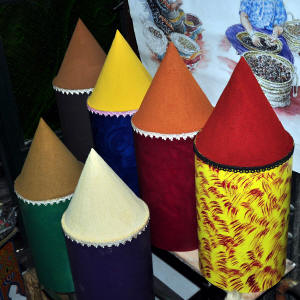
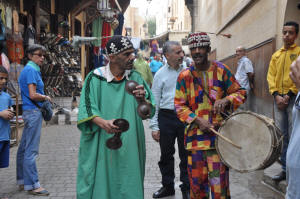
Olive merchant
Spices arranged to look like crayons
Musicians
Seeing how the people here live is endlessly fascinating.
Like many places throughout the world, the different
craftsman are grouped together so all the knife sharpeners are in one block, all
the blacksmiths in another street
etc. The knife sharpener on the right has a shop that is about 3 feet by 5
feet. There he sits all day spinning a
huge stone wheel with his foot and sharpening knives for people day after day
after day. That is his life.
The men in the left photo who make the copper bowls and
cooking utensils all work together in one large open square.
The noise when they are pounding is mind numbing and they would all likely go
nuts but they have organized a system that I assume preserves their sanity.
For awhile they all work on various quiet parts of making the utensils, then on
some
pre-agreed signal they all start pounding away. For several minutes they
all pound bowls, sinks or pots into shape
then suddenly all stop and it's quiet again. At least this way the din is
not constant.
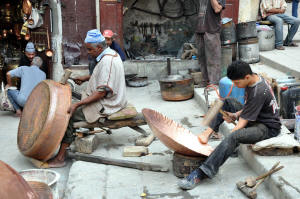
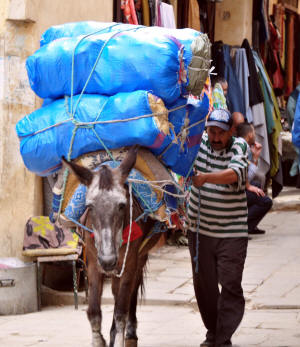
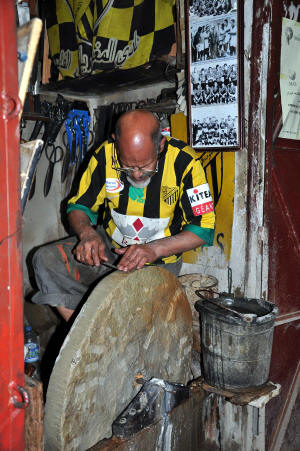
Copper utensil makers
Moving goods through the medina
Knife sharpener
A must see stop on the tour of Fez are the dying vats where they dye leather and fabrics for the many handicrafts they sell. The dyed items find their way into shoes, yarn, scarves and carpets as were were to see later in our wanderings.
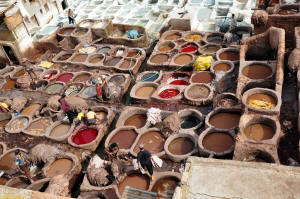
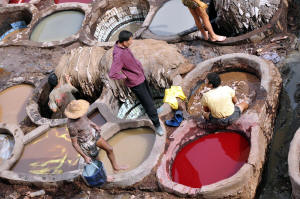
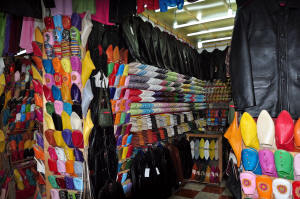
Dye vats
Dye vats
Dyed leather shoes
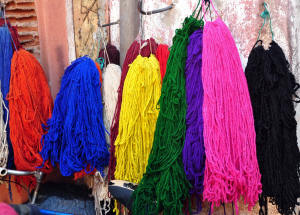
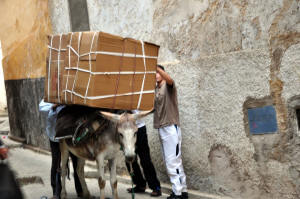
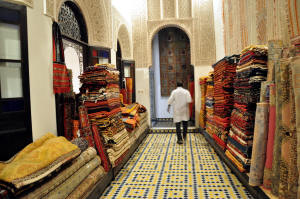
Dyed yarn
A burro's life
Carpet co-operative
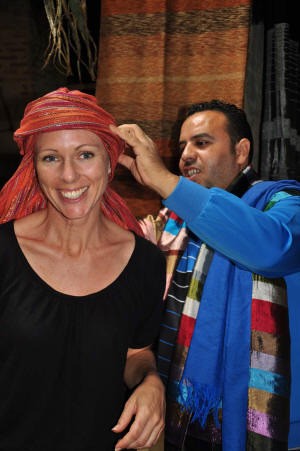
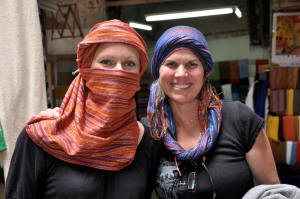
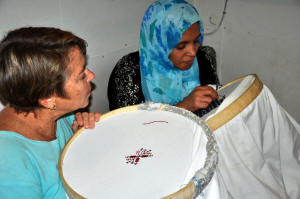
Carolyn trying on a scarf
Carolyn and Karen - Bedouin style
Dee sharing needlepoint tips
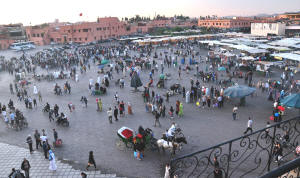
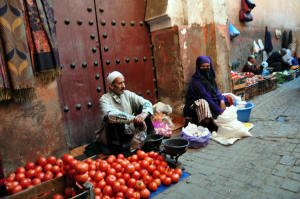
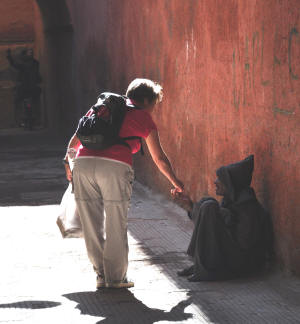
Marrakech Square
Tomato seller
Beggar
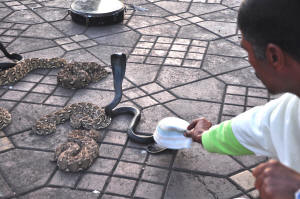
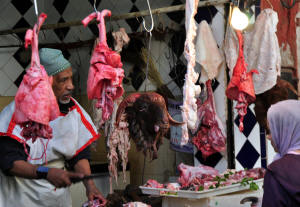
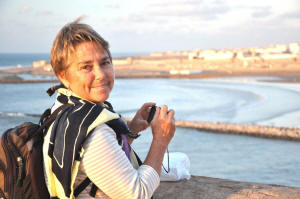
Snake charmer and cobra
Goat heads and goat meat
Overlooking the Rabat harbor opening




















